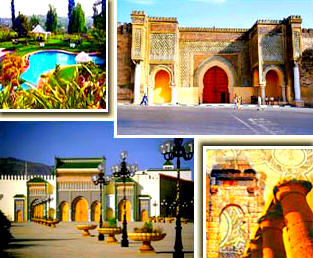 Meknes & Volubilis Meknes & Volubilis
Located between the fertile plain of the Rarb and the Middle Atlas,
Meknes
and Volubilis lie at the heart of an agricultural area that
has been Morocco's grain store since ancient times. Their historical
importance can be clearly seen in the Roman Ruins of Volubilis
(Morocco's most important archaeological site) and the grandeur of
the Moorish buildings in Meknes.
MEKNES
Today Moroco's fifth-largest city, Meknes was nothing more than a
small town overshadowed by its neighbour and rival Fez until the
reign of Moulay Ismaïl started in 1672. The sultan ambitiously set
about building gates, ramparts, mosques and palaces, he conquered
the El Badi Palace in Marrakesh and the ruins of Volubilis, and
Meknes rose to the rank of imperial city.
Bab El Mansour
Bab El Mansour is a triumphal arch standing before the imperial
city, piercing the walls of the Kasbah. Its construction started
in
1672 during the reign of Moulay Ismaïl and the gate was completed by
the sultan's son Moulay Abdallah in 1732. Of monumental proportions
– about 16m (52ft) high while the arch has a span of 8m (26ft) – and
distinguished for its decoration, Bab El Mansour
is held to be the
finest gate in Meknes, some even say in Morocco.
Dar el Ma, Lahri and the Royal
Stables
Dar el Ma (the Water House) held the town's water reserves and was
another of Moulay Ismaïl's grandiose projects. The huge building
contains 15 rooms, each with a noria (water wheel), once worked on
by the horses to draw underground water by means of scoops.
Dar el
Ma gives access to the Royal Stables and Lahri (a monumental
building with 29 aisles, designed for storing grain), which are
considered to be one of the sultan's finest creations.
Mausoleum of Moulay Ismaïl
Featuring a suite of three rooms, 12 columns and a central sanctuary
where the great sultan lies, the Moulay Ismaïl mausoleum
is in some
aspects reminiscent of the Saadian Tombs in Marrakesh. The mausoleum
was built in the 17th century and was remodelled
in the 18th and
20th centuries. Moulay Ismaïl's wife and his son Moulay Ahmed Al
Dahbi, as well as the sultan Moulay Abder Rahman (1822-59), are laid
to rest in the burial chamber, which is decorated with stuccowork
and mosaics.
Bab el Khemis and Mellah
Bab el Khemis is the main entrance of the former Mellah (Jewish
quarter), built in the 17th century on a terrain offered by Moulay
Ismaïl to a Jewish doctor who cured one of the princesses. Modern
buildings have been built on the ruins of the former Jewish quarter
and a new Mellah was built on the right of Bab el Khemis in the 20th
century. The sultan Moulay Ismaïl had several inscriptions graved
onto the gate: "I am the gate opened to all people, from East or
West." and " I am the blithe door, by my glory, at the full moon in
the sky. I was built by Moulay Ismaïl. Wealth and prosperity are
graved on my front, I am surrounded by happiness. "
VOLUBILIS
The ancient town of Volubilis was settled and began to prosper under
the Mauritanian kings, from the 3rd century BC to AD 40. Temples
from this period, as well as a strange tumulus, have been uncovered.
When Mauretania was annexed by the Roman emperor Claudius in AD 45,
Volubilis was raised to the status of municipia (free town),
becoming one of the most important cities in Tingitana. After Rome
withdrew from Mauretania in the 3rd century, the city declined and
it was inhabited by Christians until the site was Islamicized in 788
at the arrival of Idriss I.
The site was known from the 18th century, but it was not until the
late 19th century that is was first investigated. Excavations
resumed in 1915 and have continued almost uninterrupted since,
although extensive areas still remain to be investigated. Although
Volubilis is not as large as some other Roman towns, it shows how
thoroughly Romanized Mauretania Tingitana had become. The site
consists of remaining ruins showing the Roman inhabitants' daily
lives:
The Triumphal Arch – overlooks plantations of cereals and olive
trees
House of the Columns – arranged around a huge peristyle courtyard
with a circular pool
Columns with twisted fluting and composite capitals front the grand
reception room
House of the Cortège of Venus & House of the Bathing Nymphs –
contains mosaics displaying scenes of Diana, Pegasus and the nymphs
Basilica – Apart from the triumphal arch, this was the only building
whose ruins were still impressive when excavations began. This was a
meeting place of senate as well as the commercial exchange and
tribunal.
The Capitol – Of the original building dating from the early 3rd
century, only the foundations remain. Public rites in honour of
Jupiter, Juno and Minerva were performed here.
House of Orpheus – contains the remains of a large peristyle
courtyard with a square pool, an oil press and hypocausts (under
floor heating). The reception room shows the largest circular
mosaics that have been discovered in Volubilis.
MOULAY IDRISS
The most spectacular sight of Moulay idriss is from the scenic route
between Meknes and Volubilis. In a superb setting, the bright white
town clings to two rocky outcrops between which rises the tomb of
Idriss I. Descendant of Ali, son in law of the Prophet Mohamed, he
founded the first Arab-Muslim dynasty in Morocco. The tombs of
Idriss I is closed to non-Muslims, but from the terrace near the
Mosque of Sidi Abdallah el Hajjam, there is a splendid view of the
town and the mausoleum.
Weather
Winter temperature = 5 - 20°C. Summer temperature = 15 – 35°C.
Mild winters and above average annual humidity level. |